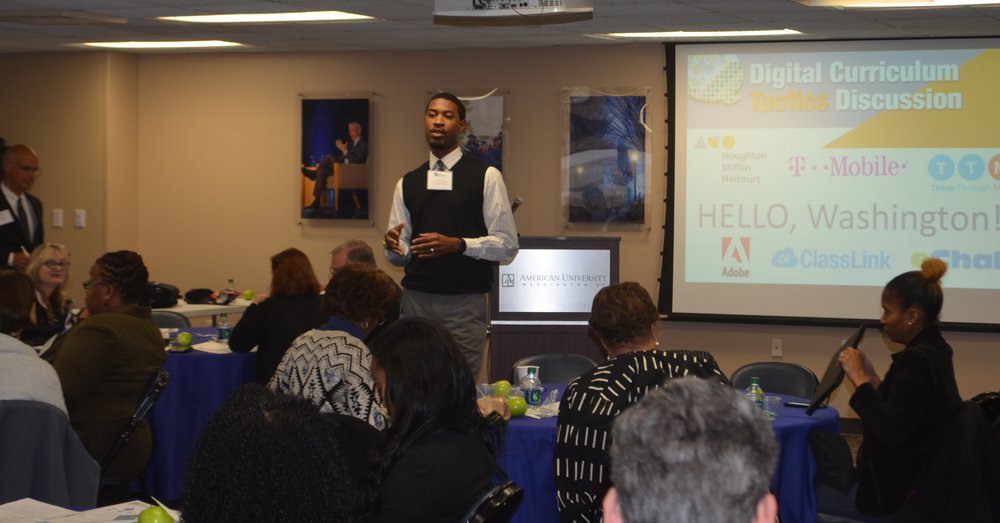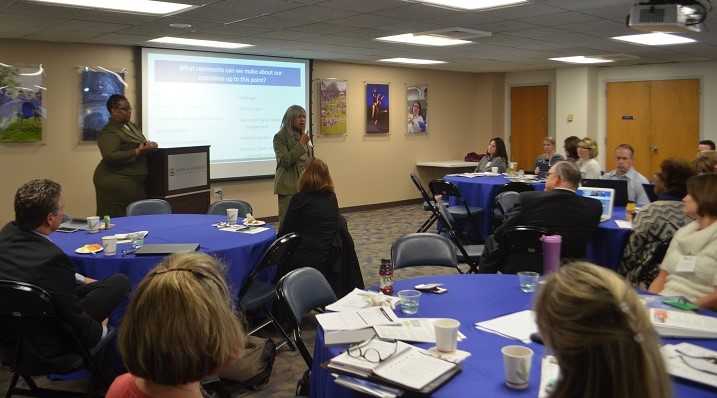The Butler Pavilion of American University was the site of the Washington D.C. Digital Curriculum Tactics Discussion in late November. Executives from schools across the region gathered to address leading issues in the shift to digital curriculum. It was a day of collaboration on winning solutions for change and context from the Learning Counsel on what’s happening nationally.
LeiLani Cauthen, CEO and Publisher of the Learning Counsel opened the discussion with a keynote on the state of the market, the scale of education transformation from strategy, through tactics, sustainability, analytics, design and to the endpoint of experiential learning. She brought everyone to an understanding of where the nation stands along this transition continuum. She also presented just released research and findings from the national survey of 708 schools concerning digital curriculum implementation and strategy.
“Just talking to the folks at my back table has been such a big thing for me so far today,” stated Skip Lee the Director of Curriculum of Anne Arundel County Schools. “LeiLani asked me to share what I mean by our 20-60-20 rule we see happening. It’s that roughly 20% of people just jump right in and another 60% sort of dither and are not straightforward but need more work and take extra time and effort, and the last 20% drag their heels and some won’t go at all.
Dr. Lisa Spencer, Director, Executive Technology Training and Support, Prince Georges County Public Schools, one of the top 25 largest districts in the nation, spoke to the whole group and added to Lee’s point. She shared how their teachers don’t necessarily see the natural fit of technology and activities in their classes. “Getting teachers on board with the transition has been a big challenge for us. We’re making progress, but it’s not fast enough. We have seventeen on-staff trainers to help instructors make the shift. The social studies group is definitely on board, but that is considered the area that is probably the least resistive because it isn’t tested quite the same.”
See Photo Gallery for DC Discussion Event
Kimberly Roberson, an Instructional Technology Specialist also from Prince Georges explained further that it is a real challenge to not be seen as the “fix it” person when staff from her team walk in to a classroom. Then tend to be considered as people who “check up” on teachers. “Lots of teachers have been of a mind to say ‘don’t mess with me’ and ‘what I am doing is working why change’ sort of view. I built something called a ‘breakfast bite’ morning session with the eighteen schools I cover, and that has been helping a lot because it meets people right where they are and doesn’t force anything.”
Addressing curriculum in lower grades
The academics team at Anne Arundel County Schools is doing a full K-5 rewrite of curriculum, which has to do with the all-over-the-place log-ins they’ve been finding. “From Day 1 to Day 81 we are full on with standards based curriculum, including counseling and two grade levels at a time with vertical association, cultural arts alignments and so forth,” stated Lee. “What we’re doing that’s interesting is we’ve tried to make a full immersion experience and incorporate more play in learning, and who can say that today? It’s important. We’ve also done more teacher observation so parents are now getting more feedback – we’ve built that into our curriculum.”
“Really, our curriculum is a website we built,” said Lee. “It has 2,700 pages, so if you printed it as curriculum, and all the additional hyperlinks, it would take a lot of print resources and days to do so we discourage that.”
LeiLani reported that she’d meant to ask Lee about what sort of developer work or animation they might consider using to build out the engagement user interface and user design in future, but the high whine of conversation throughout the day caused her to never get back to Lee to have that chat, so she plans to do that over the phone soon.
Student Choice and Collaboration
Jim Fazzino, Director of eLearning, Baltimore County Public Schools, shared that their district has focused on eLearning using an asynchronous model that allows students to be brought together virtually. This new sort of adaptive and responsive model used to be a packet of work mailed in like old home and hospital models for students with very little teacher interaction other than to drive out to the home and drop the packet off. So now, the first classes have been webinars and some courseware and teacher created materials. He said that it really seems to be resonating with teachers and students.
Fazzino also said that they are doing a lot of curating, using a lot of links and that teachers were working at differentiation and putting process behind each lesson plan.
Digital Curriculum Development and an LMS
Julie Alonso-Hughes, Instructional Technology Coordinator of Howard County Public Schools, and fellow team members, Theodore Hartman, Crystal Marshall-Krauss and Julie Wray spoke to the group, sharing that they have 76 schools and 54,870 students with 8,136 staff – not a small enterprise. Their focus has been on a master plan for curriculum development. The plan has gone through quite a sophisticated design thinking process and evaluation. They have over 350 unique curriculum courses in their Learning Management System (LMS). In addition they created and set up 48 curriculum and program communities. One of the things Julie mentioned is that they have worked very hard on creating good instructional design across subjects so there is a consistency for teachers and students. “Curriculum needs to be a living, breathing and growing document, our teachers told us,” said Alonso-Hughes. “We build units and have been using the ‘Understanding by Design Framework’,” she said. “We also put attention on the overall design because teachers were getting lost – the ‘too-many-clicks’ problem.”
Howard County had signed into the federal government’s #GoOpen project, but found that there were lots of barriers. They decided to begin moving away from a linear approach to objects and get more interactives, and now have something Julie calls a “Personal Conflict Style Inventory.” Their PD provides helpful code templates for inside Canvas (their LMS). They also used OER Commons resources to train curriculum designers.
“We’ve gotten good user feedback and have been engaging in strategic back-mapping of resources to other teachers from the ones who are using something well. In that way we are having some teachers learn from others,” said Julie.
Students at the Center of the Discussion
As one of the final speakers for the day, Dewayne McClary, Director of Educational Technology for DC Public Schools discussed how they are focused on student choice and letting the learners take charge of their own learning. “We have been working with Education Elements. We are focused on helping our students produce their own artifacts of learning,” he said. “In some instances the students are doing more of the instruction. It is centered around the ‘4C’s’ of curate, collaborate, create and communicate, which we want every student to be able to do.“
DCPS is also moving forward to a full 1-1 and using Microsoft Surface Pro 3’s for rolling out in elementary schools. They have 68 different digital curriculum objects or systems that it took them two years to get principals to cull first before their purchase of any digital content. The office of the Chief Operations Officer and CTO have a good working relationship – together they set the vision. They have a student facing high school course set and also have rolled out Office365. Hey have been using a lot of “parent nights” to introduce all of this to parents.
The Learning Counsel looks forward to seeing our colleagues and friends in Washington D.C. again next year and learning how they’ve further transformed their schools and districts to support students and teachers.












